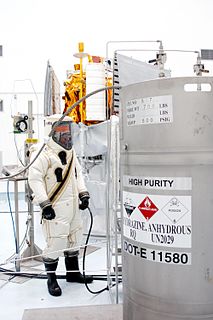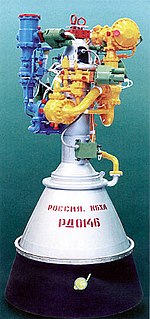Related Research Articles

A hypergolic propellant combination used in a rocket engine is one whose components spontaneously ignite when they come into contact with each other.

Liquid oxygen—abbreviated LOx, LOX or Lox in the aerospace, submarine and gas industries—is the liquid form of molecular oxygen. It was used as the oxidizer in the first liquid-fueled rocket invented in 1926 by Robert H. Goddard, an application which has continued to the present.

A liquid-propellant rocket or liquid rocket utilizes a rocket engine that uses liquid propellants. Liquids are desirable because they have a reasonably high density and high specific impulse (Isp). This allows the volume of the propellant tanks to be relatively low. It is also possible to use lightweight centrifugal turbopumps to pump the rocket propellant from the tanks into the combustion chamber, which means that the propellants can be kept under low pressure. This permits the use of low-mass propellant tanks that do not need to resist the high pressures needed to store significant amounts of gases, resulting in a low mass ratio for the rocket.
Cryogenic fuels are fuels that require storage at extremely low temperatures in order to maintain them in a liquid state. These fuels are used in machinery that operates in space where ordinary fuel cannot be used, due to the very low temperatures often encountered in space, and the absence of an environment that supports combustion. Cryogenic fuels most often constitute liquefied gases such as liquid hydrogen.
The highest specific impulse chemical rockets use liquid propellants. They can consist of a single chemical or a mix of two chemicals, called bipropellants. Bipropellants can further be divided into two categories; hypergolic propellants, which ignite when the fuel and oxidizer make contact, and non-hypergolic propellants which require an ignition source.

The staged combustion cycle is a power cycle of a bipropellant rocket engine. In the staged combustion cycle, propellant flows through multiple combustion chambers, and is thus combusted in stages. The main advantage relative to other rocket engine power cycles is high fuel efficiency, measured through specific impulse, while its main disadvantage is engineering complexity.

The China Aerospace Science and Technology Corporation (CASC) is the main contractor for the Chinese space program. It is state-owned and has a number of subordinate entities which design, develop and manufacture a range of spacecraft, launch vehicles, strategic and tactical missile systems, and ground equipment. It was officially established in July 1999 as part of a Chinese government reform drive, having previously been one part of the former China Aerospace Corporation. Various incarnations of the program date back to 1956.

Avio S.p.A. is an Italian company operating in the aerospace sector with its head office in Colleferro, Rome, Italy. Founded in 1908, it is present in Italy and abroad with different commercial offices and 10 production sites. Avio operates in 5 main business areas in the civil and military sectors:

The Liquid Propulsion Systems Centre (LPSC) is a research and development centre functioning under Indian Space Research Organisation. It has two units located at Valiamala, in Thiruvananthapuram of Kerala, and Bengaluru of Karnataka. LPSC is augmented by ISRO Propulsion Complex at Mahendragiri of Tamil Nadu.
The Future Launchers Preparatory Programme (FLPP) is a technology development and maturation programme of the European Space Agency (ESA). It develops technologies for the application in future European launch vehicles (launchers) and in upgrades to existing launch vehicles. By this it helps to reduce time, risk and cost of launcher development programmes.
Started in 2004, the programmes initial objective was to develop technologies for the Next Generation Launcher (NGL) to follow Ariane 5. With the inception of the Ariane 6 project, the focus of FLPP was shifted to a general development of new technologies for European launchers.
FLPP develops and matures technologies that are deemed promising for future application but currently do not have a sufficiently high technology readiness level (TRL) to allow a clear assessment of their performance and associated risk. Those technologies typically have an initial TRL of 3 or lower. The objective is to raise the TRL up to about 6, thus creating solutions which are proven under relevant conditions and can be integrated into development programmes with reduced cost and limited risk.

The RD-0146 is a Russian cryogenic rocket engine. The RD-0146 engine was developed by KBKhA design bureau in Voronezh, Russia, in cooperation with the American Pratt & Whitney Rocketdyne company. In 2009, it came into prominence, as Russian space agency chose it for the second-stage of the proposed Rus-M launch vehicle designed to carry the future Russian PPTS crewed spacecraft. After the cancellation of Rus-M rocket, the RD-0146D variant was selected as the powerplant for the KVTK upper stage.
The RS-18 is a reconfigured version of the Rocketdyne Lunar Module Ascent Engine (LMAE), modified to burn liquid oxygen (LOX) and liquid methane (CH4) for NASA's Exploration Systems Architecture Study (ESAS) engine testing in 2008.

Since the founding of SpaceX in 2002, the company has developed four families of rocket engines — Merlin, Kestrel, Draco and SuperDraco — and is currently developing another rocket engine: Raptor, and after 2020, a new line of methox thrusters.

The ISRO Propulsion Complex (IPRC), located at Mahendragiri of Tamil Nadu, is an Indian Space Research Organisation centre involved in testing, assembling, and integrating propulsion systems and stages that are developed at ISRO's Liquid Propulsion Systems Centres. Formerly, IPRC was known as LPSC, Mahendragiri, functioning under LPSC. It was elevated as an independent centre and renamed as IPRC with effect from 1 February 2014.
Thomas Mueller is an American rocket engineer and rocket engine designer. He was a founding employee of SpaceX, an American aerospace manufacturer and space transportation services company headquartered in Hawthorne, California.

A marine LNG engine is a dual fuel engine that uses natural gas and bunker fuel to convert chemical energy in to mechanical energy. Due to natural gas’ cleaner burning properties, the use of natural gas in merchant ship propulsion plants is becoming an option for companies in order to comply with IMO and MARPOL environmental regulations. The natural gas is stored in liquid state (LNG) and the boil-off gas is routed to and burned in dual fuel engines. Shipping companies have been cautious when choosing a propulsion system for their fleets. The steam turbine system has been the main choice as the prime mover on LNG carriers over the last several decades. The decades-old system on steam propelled LNG carriers uses BOG. LNG carriers are heavily insulated to keep the LNG at around -160 °C – to keep it liquefied. What happens is that even with all the insulation, the LNG containment area is penetrated by heat which allows for naturally generated boil-off gas (BOG).
The Soyuz-7 is a proposed family of new Russian rockets proposed by JSC SRC Progress in the mid-2010s, to replace the legacy Soyuz for launch after the early 2020s. JSC SRC Progress had been the manufacturer and custodian of the Soyuz family design for many decades. The new design concept was a part of Project Feniks. While all previous iterations of the Soyuz family had their roots firmly set on the R-7 ICBM legacy, the new rocket, designated Soyuz-7 in 2013, was to be a completely new design from the ground up. The proposed new design was to be based on a new propellant: LOX and liquid methane, use a new tank structure, new propulsion, and would do away with the famous Korolev cross, and have thrust vector control in the main engine rather than using vernier engines. It was conceived in 2013 to be a scalable family with three versions covering the medium to heavy payload ranges.
WIRES is a Japanese project developing a winged single-stage reusable suborbital rocket as a test bed for a reusable orbital launch system or a crewed suborbital spaceplane. The full-size prototype, called WIRES-X, is expected to be launched in 2020.

Raptor is a family of full-flow staged combustion cycle rocket engines developed and manufactured by SpaceX, for use on the in-development Starship fully reusable launch vehicle. The engine is powered by cryogenic liquid methane and liquid oxygen (LOX), rather than the RP-1 kerosene and LOX used in SpaceX's prior Merlin and Kestrel rocket engines. The Raptor engine has more than twice the thrust of SpaceX's Merlin engine that powers their current Falcon 9 and Falcon Heavy launch vehicles.

M10 is a liquid-fuel upper-stage rocket engine in development by Avio on behalf of European Space Agency for use on Vega E. The engine, initially known as LM10-MIRA, is a derivation of the existing Russian RD-0146 engine and result of a collaboration between Avio and Chemical Automatics Design Bureau (KBKhA) ended in 2014. As of March 2021 the engine ground qualification is foreseen for 2024 with consequent maiden flight on a Vega-E launcher by 2025.